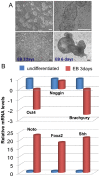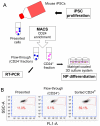Differentiation of mouse induced pluripotent stem cells (iPSCs) into nucleus pulposus-like cells in vitro
- PMID: 24086564
- PMCID: PMC3783442
- DOI: 10.1371/journal.pone.0075548
Differentiation of mouse induced pluripotent stem cells (iPSCs) into nucleus pulposus-like cells in vitro
Abstract
A large percentage of the population may be expected to experience painful symptoms or disability associated with intervertebral disc (IVD) degeneration - a condition characterized by diminished integrity of tissue components. Great interest exists in the use of autologous or allogeneic cells delivered to the degenerated IVD to promote matrix regeneration. Induced pluripotent stem cells (iPSCs), derived from a patient's own somatic cells, have demonstrated their capacity to differentiate into various cell types although their potential to differentiate into an IVD cell has not yet been demonstrated. The overall objective of this study was to assess the possibility of generating iPSC-derived nucleus pulposus (NP) cells in a mouse model, a cell population that is entirely derived from notochord. This study employed magnetic activated cell sorting (MACS) to isolate a CD24(+) iPSC subpopulation. Notochordal cell-related gene expression was analyzed in this CD24(+) cell fraction via real time RT-PCR. CD24(+) iPSCs were then cultured in a laminin-rich culture system for up to 28 days, and the mouse NP phenotype was assessed by immunostaining. This study also focused on producing a more conducive environment for NP differentiation of mouse iPSCs with addition of low oxygen tension and notochordal cell conditioned medium (NCCM) to the culture platform. iPSCs were evaluated for an ability to adopt an NP-like phenotype through a combination of immunostaining and biochemical assays. Results demonstrated that a CD24(+) fraction of mouse iPSCs could be retrieved and differentiated into a population that could synthesize matrix components similar to that in native NP. Likewise, the addition of a hypoxic environment and NCCM induced a similar phenotypic result. In conclusion, this study suggests that mouse iPSCs have the potential to differentiate into NP-like cells and suggests the possibility that they may be used as a novel cell source for cellular therapy in the IVD.
Conflict of interest statement
Figures





Similar articles
-
Human iPSCs can be differentiated into notochordal cells that reduce intervertebral disc degeneration in a porcine model.Theranostics. 2019 Oct 12;9(25):7506-7524. doi: 10.7150/thno.34898. eCollection 2019. Theranostics. 2019. PMID: 31695783 Free PMC article.
-
Notochordal cell conditioned medium stimulates mesenchymal stem cell differentiation toward a young nucleus pulposus phenotype.Stem Cell Res Ther. 2010 Jun 16;1(2):18. doi: 10.1186/scrt18. Stem Cell Res Ther. 2010. PMID: 20565707 Free PMC article.
-
Notochordal cells protect nucleus pulposus cells from degradation and apoptosis: implications for the mechanisms of intervertebral disc degeneration.Arthritis Res Ther. 2011;13(6):R215. doi: 10.1186/ar3548. Epub 2011 Dec 29. Arthritis Res Ther. 2011. PMID: 22206702 Free PMC article.
-
Differentiation of Pluripotent Stem Cells into Nucleus Pulposus Progenitor Cells for Intervertebral Disc Regeneration.Curr Stem Cell Res Ther. 2019;14(1):57-64. doi: 10.2174/1574888X13666180918095121. Curr Stem Cell Res Ther. 2019. PMID: 30227822 Review.
-
Intervertebral disc repair and regeneration: Insights from the notochord.Semin Cell Dev Biol. 2022 Jul;127:3-9. doi: 10.1016/j.semcdb.2021.11.012. Epub 2021 Dec 2. Semin Cell Dev Biol. 2022. PMID: 34865989 Review.
Cited by
-
Developments in intervertebral disc disease research: pathophysiology, mechanobiology, and therapeutics.Curr Rev Musculoskelet Med. 2015 Mar;8(1):18-31. doi: 10.1007/s12178-014-9253-8. Curr Rev Musculoskelet Med. 2015. PMID: 25694233 Free PMC article.
-
Biomaterials and Cell-Based Regenerative Therapies for Intervertebral Disc Degeneration with a Focus on Biological and Biomechanical Functional Repair: Targeting Treatments for Disc Herniation.Cells. 2022 Feb 9;11(4):602. doi: 10.3390/cells11040602. Cells. 2022. PMID: 35203253 Free PMC article. Review.
-
Differentiation of human induced pluripotent stem cells into nucleus pulposus-like cells.Stem Cell Res Ther. 2018 Mar 9;9(1):61. doi: 10.1186/s13287-018-0797-1. Stem Cell Res Ther. 2018. PMID: 29523190 Free PMC article.
-
Inflammation in intervertebral disc degeneration and regeneration.J R Soc Interface. 2015 Mar 6;12(104):20141191. doi: 10.1098/rsif.2014.1191. J R Soc Interface. 2015. PMID: 25673296 Free PMC article. Review.
-
Notochordal cells: A potential therapeutic option for intervertebral disc degeneration.Cell Prolif. 2024 Feb;57(2):e13541. doi: 10.1111/cpr.13541. Epub 2023 Sep 11. Cell Prolif. 2024. PMID: 37697480 Free PMC article. Review.
References
-
- Setton LA, Bonassar L, Masuda K (2007) Regeneration and Replacement of the Intervertebral Disc in Principles of Tissue Engineering In: Lanza R, Langer R, Vacanti JP. 3rd ed. Elsevier Science.
-
- Humzah MD, Soames RW (1988) Human intervertebral disc: structure and function. Anat Rec 220: 337-356. doi:10.1002/ar.1092200402. PubMed: 3289416. - DOI - PubMed
-
- Roberts S, Menage J, Duance V, Wotton S, Ayad S (1991) 1991 Volvo Award in basic sciences. Collagen types around the cells of the intervertebral disc and cartilage end plate: an immunolocalization study. Spine (Phila Pa 1976 16: 1030-1038. - PubMed
Publication types
MeSH terms
Substances
Grants and funding
LinkOut - more resources
Full Text Sources
Other Literature Sources
Miscellaneous

